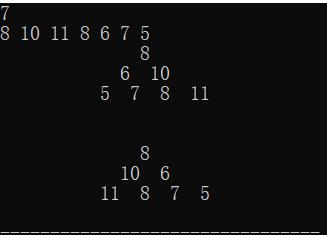所谓二叉搜索树的“镜像”,即将所有结点的左右子树对换位置后所得到的树。
一个二叉搜索树经过变换之后,其对应的所有子树的左右节点都得到了互换。
镜像变换采用递归的思路,让根节点的左节点进行镜像变化,右节点进行镜像变化,之后再将左右节点进行镜像变化,最终返回root。
测试用例:
7
8 10 11 8 6 7 5
效果图:

#include<bits/stdc++.h>
using namespace std;
const int N = 1010;
struct TreeNode{
int val;
TreeNode *left;
TreeNode *right;
TreeNode(int x) : val(x),left(NULL),right(NULL) {}
};
int n,num;
TreeNode *root,*mirror_root;
TreeNode* insert(TreeNode* root,int val) //插入节点构造二叉搜索树
{
if(!root)
{
root = new TreeNode(val);
}
else if(root->val > val) root->left = insert(root->left,val);
else root->right = insert(root->right,val);
return root;
}
TreeNode* mirror(TreeNode* root) //镜像变化函数
{
if(!root) return NULL;
root->left = mirror(root->left); //左节点镜像变化
root->right = mirror(root->right); //右节点镜像变化
auto temp = root->left; //左右节点进行交换
root->left = root->right;
root->right = temp;
return root; //返回根节点的值
}
void bfs(TreeNode *root)
{
queue<TreeNode*> q;
q.push(root);
int x=0;
while(q.size())
{
int len=q.size();
for(int i=0;i<len;i++)
{
int space=2*(n-x);
auto t = q.front();
q.pop();
if(i==0) for(int i=0;i<space;i++) cout<<" ";
else for(int i=0;i<2;i++) cout<<" ";
cout<<t->val;
if(t->left) q.push(t->left);
if(t->right) q.push(t->right);
}
cout<<endl;
x++;
}
}
int main()
{
cin>>n;
for(int i=0;i<n;i++)
{
cin>>num;
root = insert(root,num);
}
bfs(root);
cout<<endl;
cout<<endl;
mirror_root = mirror(root);
bfs(mirror_root);
return 0;
}


这个图。。。